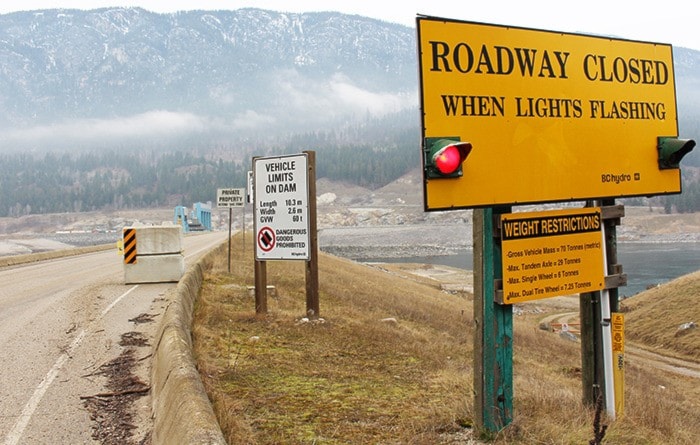Tempers ran high last Thursday night as residents registered their objections to closing the deck of the Hugh L. Keenleyside Dam.
BC Hydro held a public meeting at the Castlegar Complex to discuss the possibility of closing the dam deck to the public, citing traffic safety concerns.
Chris Egan, plant manager for the Keenleyside Dam, told those in attendance that there was potential for head-on collisions such as the near-miss on August 15, 2011, which BC Hydro cited as an example of why it’s dangerous to allow public traffic on the dam deck in both a press release preceding the meeting and at the meeting itself. Egan went on to say that drivers on the deck have been known to speed and ignore traffic signals and directions, that blind corners and limited sight lines make it riskier to drive on the deck and that there is damage to the dam from oversized vehicles and a risk to workers when traffic is on the bridge.
BC Hydro is currently in the midst of the Spillway Gates project, so there have been a number of workers on the deck.
“The intent of the Spillway Gates project is it’s a reliability project, so it’s to upgrade the ability of the spillway gates — the low level gates — to operate through the whole cycle of movement even after fairly serious seismic events, etc.,” explained Egan.
Attendees at the meeting asked why a current construction project should mean closing the deck of the dam permanently. Egan’s response was that there is daily maintenance taking place on the dam; it’s not just the one larger project.
Since the Arrow Lakes Generating Station was constructed downstream, the Keenleyside Dam’s maintenance program has increased, as the operation of the dam is now more complicated.
“We provide the storage; they generate the power, but we have to have that immediate response now to their units tripping offline,” explained Egan. “That didn’t used to exist because we would be able to set the gates, maintain those flows. Now with them running on units, if the unit trips, they stop discharge, we have to bring that up.”
Members of the public raised four main points at the meeting:
1) Residents were concerned that closing the dam would impact tourism;
2) They saw the closure of the deck as another broken promise from BC Hydro;
3) The public did not believe that the risk of driving on the dam was as high as BC Hydro claimed;
4) Residents were concerned with the risk of increased traffic on Robson Rd.
In addressing concerns about tourism, BC Hydro employees pointed out that the earth-filled portion of the dam will remain open to the public as there are no safety concerns. That way tourists can still visit the dam and view the navigational lock.
As for broken promises, Mary Anne Coules, community relations for BC Hydro, said there never was a promise to keep the dam open to the public.
“We’ve done a review of the materials, because it’s something that’s been brought up in the past. So we have gone through all of our historical records, [and] there’s no record of any promise made to the community to provide access,” she said. “It was something that we historically allowed, but … with the building of the Robson Bridge it became redundant for the majority of people.”
Dave Cattawach, the public safety consultant who conducted a risk assessment of Keenleyside Dam, also helped develop the Canadian Dam Association Guidelines, which are used in the risk assessment. He presented his findings to the public and showed that the risk of allowing traffic on the bridge had been rated at 16, which is considered high risk and must be addressed.
The problem is that the public disagreed with Cattawach’s assessment.
“The way they’ve calculated it seems to me to be quite arbitrary. It may not be arbitrary, but if you look at the comparative risk of driving over the dam, versus driving through a parking lot in Castlegar or for example, going on the route that goes from the theatre to Mark’s Work Wearhouse, going the back way, it’s the same issues with 90 degree turns and sight lines and we all drive that with no problems,” said Tim Charman, a Robson resident who attended the meeting. “So I think what they’re having as risks here are highly inflated compared to what the public would perceive as risks.”
Those who attended the meeting seemed to generally agree with Charman, and some suggested that even if vehicle traffic was ultimately closed to the public, cyclists and pedestrians should still be allowed access to the bridge.
Following the meeting, Cattawach acknowledged that it’s difficult to reconcile public perception with formal risk assessment.
“It’s perception. There’s a scientific approach that’s been well proven, it’s been applied to hundreds of dams throughout Canada and it works, but when you look at a public’s perception of that same risk, it’s different,” he said.
Residents also raised concerns about the safety of Robson Rd., but as the road is outside of BC Hydro’s purview, there wasn’t much any of the BC Hydro representatives could say about it.
Over 40 people attended the meeting. Following the presentation they were invited to speak with BC Hydro staff and contribute ideas to address safety concerns as well as community concerns and values.
As for next steps, BC Hydro employees will continue to collect input from the public and will report back.
“We’ve got to take this back and see how long it’s going to take us to look into the suggestions that were made tonight, and what we’ll do once we do that is we’ll report back out and let folks know where we’re at and let them know what the next steps are,” said Coules.
